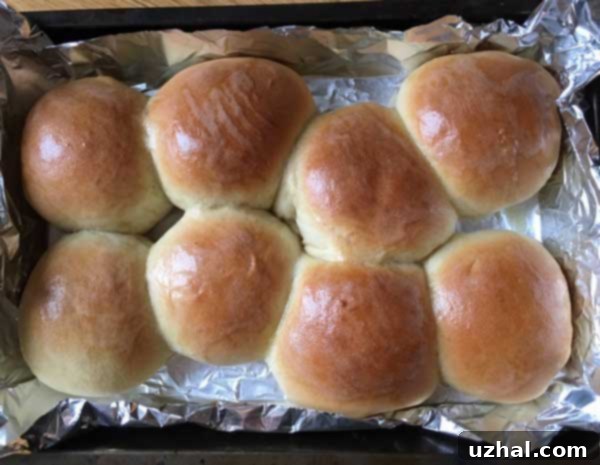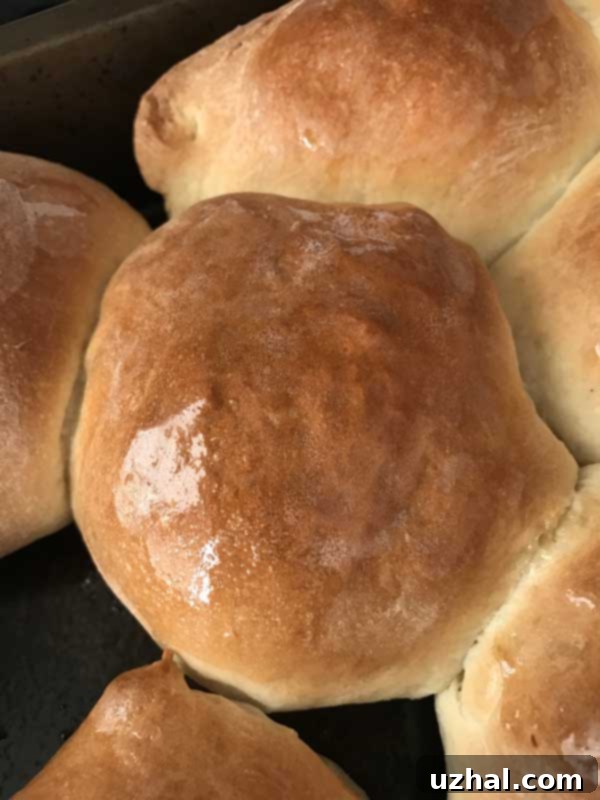Perfectly Fluffy Dinner Rolls: Your Guide to Irresistible Homemade Bread
There’s nothing quite like the aroma of freshly baked bread filling your home, and these fluffy dinner rolls are no exception. While I recently experimented with a food processor for yeast bread, today we’re returning to a trusted kitchen companion: the stand mixer. This method ensures a hands-off kneading process, making these soft, cloud-like dinner rolls achievable for even novice bakers. Get ready to impress your family and friends with these warm, buttery delights that are surprisingly simple to make from scratch.

Discovering the Ideal Small Batch Dinner Roll Recipe
This particular recipe for fluffy dinner rolls yields approximately 8 large, generously sized rolls. It’s a fantastic small batch option, ideal for a family dinner or a cozy gathering without leaving you with too many leftovers. However, for those hosting a larger crowd or simply wanting more of these delectable rolls, rest assured that doubling the recipe is incredibly straightforward. In fact, this recipe was originally adapted by halving a larger one, so scaling it up poses no issues whatsoever. This flexibility makes it a versatile addition to your baking repertoire, allowing you to easily adjust to your needs.
Whether you’re making them for a weeknight meal or a special occasion, these rolls are designed to be a stress-free experience. The stand mixer does most of the heavy lifting, ensuring a perfectly kneaded dough every time. The result? Rolls that are consistently soft, light, and wonderfully tender – the kind that disappear quickly from the bread basket!

The Importance of Accurate Flour Measurement in Baking
Baking, particularly with yeast breads, is often considered a science, and nowhere is this more evident than in ingredient measurements. A crucial aspect often overlooked is the weight of flour. As a side note from my own baking adventures, I’ve observed a noticeable difference in flour weight depending on location. For instance, since relocating to Chicago, I’ve found that 1 cup of all-purpose flour typically weighs around 5 ounces. This is in contrast to my 16 years in Austin, where 1 cup of flour consistently weighed closer to 4.5 ounces. This subtle difference can significantly impact the final texture of your baked goods.
What causes this variation? It could very well be the humidity levels. Flour, being hygroscopic, readily absorbs moisture from the air. In a more humid environment, flour can become heavier as it takes on more water, leading to a denser cup measure by volume. This phenomenon highlights why measuring by weight, using a reliable kitchen scale, is paramount for consistent baking results, especially when making delicate items like these fluffy dinner rolls.
For this specific recipe, my 2 ½ cups of all-purpose flour weighed precisely 12.5 ounces, which translates to approximately 350 grams. This measurement proved to be the absolute perfect amount, yielding a soft, pliable dough that resulted in incredibly light and airy rolls. If you’re encountering inconsistent results with your bread recipes, investing in a kitchen scale and measuring your flour by weight rather than volume could be the game-changer you need. It takes the guesswork out of baking and ensures your rolls are consistently delightful, regardless of your local climate!

More Delicious Yeast Bread & Roll Recipes to Explore
If you’re enjoying the journey of baking homemade bread, here are a few other fantastic recipes to try. From savory to sweet, these options are perfect for expanding your baking skills and delighting your taste buds:
- Cottage Cheese Dinner Rolls: A unique twist that adds incredible tenderness.
- Soft and Fluffy Coconut Milk Bread: A delightful bread with a hint of coconut flavor.
- Dinner Rolls and Focaccia: Explore a wider range of savory bread options.
- Cook’s Illustrated Fluffy Yellow Cake — Best Yet!: For those with a sweet tooth, a truly exceptional cake recipe.
- Our Favorite Fluffy Cheesecake: Another fluffy favorite, this time in dessert form.
Secrets to Achieving the Softest Homemade Dinner Rolls
Before we dive into the step-by-step instructions, let’s talk about what makes these soft dinner rolls truly stand out. The combination of warm water, melted butter, and a lightly beaten egg adds richness and moisture to the dough, which are key components for that desirable fluffy texture. Using quick-rising yeast helps speed up the proofing process without compromising on flavor or rise. The method of gradually adding flour ensures you achieve the perfect dough consistency – not too sticky, not too dry, but just right for excellent kneading and a beautiful rise.
Another often-underestimated aspect is the kneading process. While the stand mixer does the hard work, understanding what to look for in a properly kneaded dough is vital. You want it to be smooth, elastic, and pass the “windowpane test” (where a small piece of dough can be stretched thin enough to see light through it without tearing). This develops the gluten, which is essential for trapping the gases produced by the yeast, leading to those signature air pockets that make rolls so light and fluffy.
Fluffy Dinner Rolls Recipe

Fluffy Dinner Rolls
Anna
Pin Recipe
Ingredients
- 2 ½ cups all-purpose flour (350 grams)
- 2 tablespoons plus 2 teaspoons granulated sugar (35 grams)
- ¾ teaspoon salt
- 1 ½ teaspoons quick rising yeast
- 2 tablespoons plus 2 teaspoons melted unsalted butter (40 grams)
- ¾ cup hot water (125 degrees) (170 grams)
- 2 tablespoons lightly beaten egg
Instructions
-
In the bowl of a stand mixer, combine 1 cup (130 grams) of the flour, sugar, salt, and yeast. Add the butter and stir until thoroughly mixed, then stir in the water, followed by the egg. Stir well (you can do it by hand or with the paddle), and then add remaining flour ½ cup at a time until you have a soft dough.
-
Attach the dough hook to the mixer and begin kneading the dough. Dough should leave the sides of the bowl, but still stick to the bottom. Knead for about 10 minutes or until dough is smooth and elastic. Transfer to a well-oiled bowl and roll the dough around so that it’s coated in oil. Cover bowl and let dough rise until doubled in bulk (45 minutes to an hour).
-
Punch down the dough.
-
Grease a 9×13 inch metal pan. Pinch off chunks of dough, gently shaping them into balls, and arrange dough balls in the pan spacing as evenly as you can. Cover and let rise again for about 45 minutes.
-
Bake at 375° for about 25 minutes or lightly browned. Remove from oven and brush with more melted butter.
Notes
Tips for Baking Perfect Fluffy Dinner Rolls Every Time
Achieving consistently soft dinner rolls is easier than you think with a few key tips:
- Don’t Over-Flour: It’s tempting to add more flour if the dough is sticky, but this can lead to dry, dense rolls. Always start with the recommended amount and only add more in small increments if absolutely necessary. The dough should be soft and slightly tacky, not stiff.
- Warm Water is Key: Ensure your water is around 120-130°F (49-54°C). Too cold, and the yeast won’t activate; too hot, and it will kill the yeast. A quick-read thermometer is a baker’s best friend here.
- Proper Kneading: Don’t skimp on kneading time. The 10 minutes in the stand mixer is crucial for developing the gluten structure that gives these rolls their signature chewiness and fluffy texture. A well-kneaded dough will feel smooth and elastic.
- Warm Rising Environment: Yeast loves warmth. Find a warm, draft-free spot for your dough to rise. A turned-off oven with the light on, or a sunny spot, works wonderfully.
- Don’t Over-Proof: While rising is important, over-proofing can lead to rolls that collapse in the oven or have a yeasty, alcoholic flavor. Dough should double in size, but not look excessively puffy or stretched.
- Brush with Butter: The final brush of melted butter after baking adds incredible flavor, a beautiful sheen, and helps keep the crust soft.
Storage and Reheating for Maximum Freshness
These homemade dinner rolls are best enjoyed fresh, warm from the oven. However, if you have leftovers, they can be stored in an airtight container at room temperature for 2-3 days. For longer storage, wrap them tightly in plastic wrap and then foil, and freeze for up to 1-2 months. To reheat, simply warm them in a preheated oven at 300°F (150°C) for 5-10 minutes, or microwave for 15-30 seconds until warm and soft.
Serving Suggestions: Elevate Your Meal with These Versatile Rolls
These fluffy dinner rolls are incredibly versatile and pair well with a multitude of dishes. Serve them warm with a generous smear of butter, a drizzle of honey, or your favorite jam for a delightful breakfast or snack. They are also the perfect accompaniment to hearty stews, chili, soups, roasts, or any family-style meal. For a gourmet touch, consider serving them with a flavored butter, such as garlic herb butter or honey cinnamon butter.
Troubleshooting Common Dinner Roll Problems
Even experienced bakers can encounter issues. Here’s how to tackle common problems when making your stand mixer dinner rolls:
- Dense Rolls: This is often caused by too much flour, insufficient kneading, or yeast that isn’t active. Double-check your flour measurement (preferably by weight), ensure you knead long enough, and always check your yeast for freshness.
- Rolls Didn’t Rise: The culprit is almost always inactive yeast or water that was too hot or too cold. Make sure your yeast is fresh and your water temperature is accurate. A warm rising environment is also crucial.
- Dry Rolls: Too much flour is the primary cause here. Resist the urge to add excess flour during kneading. The dough should be soft and slightly tacky.
- Tough Rolls: This can be due to over-kneading (less common with a stand mixer, but possible) or not enough fat in the dough. This recipe includes butter for tenderness, so focus on proper kneading without going overboard.
Creative Variations for Your Homemade Dinner Rolls
While these easy dinner rolls are fantastic on their own, don’t hesitate to get creative with variations:
- Garlic & Herb: Mix in 1-2 teaspoons of garlic powder and 1 tablespoon of dried Italian herbs (or fresh chopped herbs) with the dry ingredients. Brush with garlic butter after baking.
- Cheesy Rolls: Fold in ½ cup of shredded cheddar or Parmesan cheese during the last minute of kneading.
- Sweet Cinnamon Rolls: Brush the flattened dough with melted butter, sprinkle with cinnamon sugar, roll up, slice, and bake as traditional cinnamon rolls.
- Sesame Seed Topping: Brush the shaped rolls with an egg wash before the second rise and sprinkle with sesame seeds for a nutty flavor and texture.
Baking homemade yeast rolls is a rewarding experience, and this recipe for fluffy dinner rolls is designed to make it as enjoyable and successful as possible. With a little patience and these helpful tips, you’ll be creating bakery-quality bread right in your own kitchen. Enjoy the process, and savor every bite of these truly irresistible rolls!
